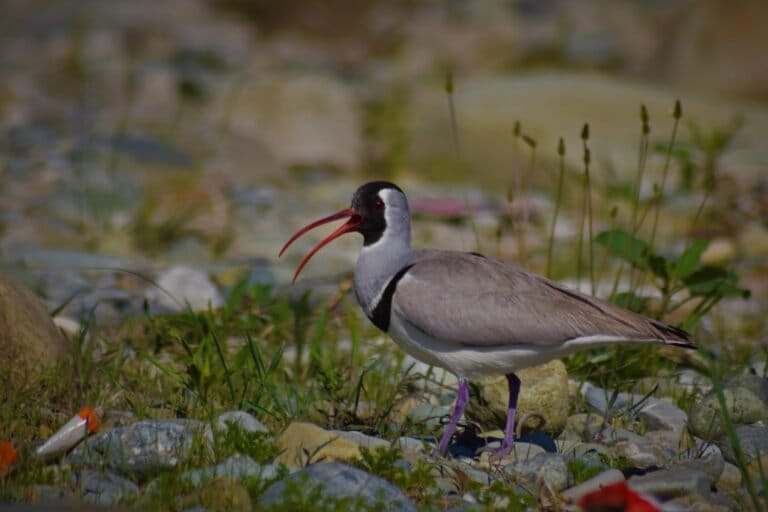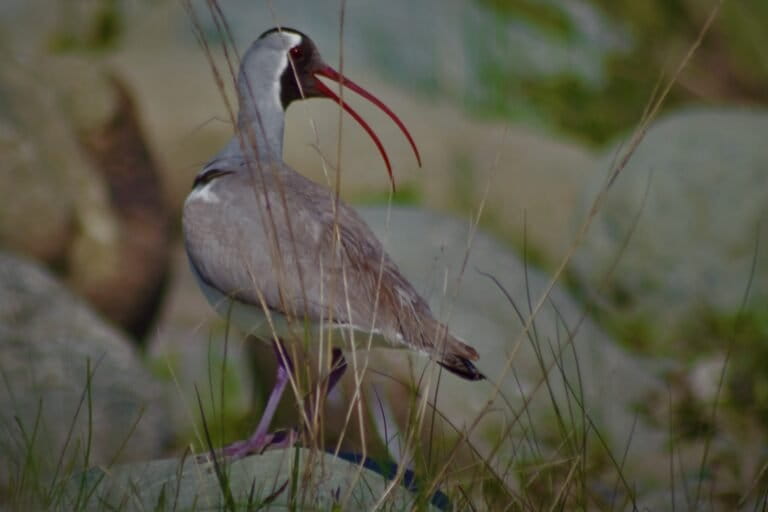- Owing to its wide range, the ibisbill is recorded only in highly specialised riverine habitats and is a rare sight. Its population remains unknown across its range in southern Central Asia.
- Several anthropogenic pressures continue to impact the species (Ibidorhyncha struthersii), with sand and boulder mining being its biggest threat.
- Researchers also highlight that ground nesting birds including the ibisbill, can be impacted by changing climatic patterns in the Indian Himalayas.
Perfectly camouflaged against the boulder-strewn streams in its high-altitude habitat, the ibisbill (Ibidorhyncha struthersii) has fascinated many nature enthusiasts and bird experts for centuries. It is known as the ‘wonder bird of the Himalayas’ owing to its elusive nature and rarity.
The mountains of the Kashmir Himalayas and Tibetan Plateau contain the most glaciated terrain outside of Earth’s poles. As they freeze and thaw, Himalayan glaciers both generate and recharge high-altitude wetlands (HAWs), typically defined as areas of temporary or permanent saturation located 3000 metres above sea level (m asl) and between the tree line and permanent snow line. The high-altitude wetlands are important sources and resources for water, biodiversity, livelihoods and ecosystem dynamics. Many of these HAWs are home to the ibisbill.

Experts say that unlike other riverine birds, the ibisbill nests in small islands of the third-order streams (waterways in the upper reaches of the watershed) being interrupted with boulders and pebbles. Although they are listed as a species of ‘Least Concern’ in the IUCN Red List of Threatened Species, these ground-nesters that occupy a huge range across the highlands of southern Central Asia, prefer distinctive riverine habitats, which makes them an uncommon sight.
In India, the bird has been recorded in Jammu and Kashmir, Ladakh, pockets of Uttarakhand and Sikkim, and a few sites in northeast India.
A recent two-year study published in 2022 has documented several threats faced by the species at six sites along the high-altitude Sindh River in Ganderbal district of Central Kashmir.
The findings revealed that sand and boulder mining was the most prevalent disturbance (38%), followed by human presence (37%), livestock grazing (12%), and predation by natural predators and free-ranging dogs (9%).
“Other disturbances observed were by birds (4%) such as black kite (Milvus migrans), jackdaw (Corvus monedula), and yellow-billed blue magpie (Urocissa flavirostris). These disturbances were highest at Kijpora (2.61 disturbances/hour) and least at Sonamarg (0.29 disturbances/hour). Kijpora witnessed the highest level of disturbances from human activities like mining, fishing, and tourism,” the study mentioned.
Looking for the ibisbill
Lead author of the study, Iqram ul Haq, who has conducted extensive research on the ibisbill in Kashmir Himalayas notes that the global range of the bird extends from eastern Kazakhstan to northeast China, Tibet and northern parts of the Indian subcontinent. Despite having a large distribution range, the global population size and population trend of ibisbill have not been quantified yet.
Information on ibisbill populations continues to remains scarce, except for some research from parts of China, the only country where their population is estimated. An accurate estimation has not yet been done in India.
Haq noted the presence of the bird at several sites along the Sindh river (Wayul, Wussan, Kijpora, Sonmarg, Nilgrath and Baltal) and were sparsely distributed, occupying shingle river bed areas with small pebbles, cobbles, boulders and moderate flow of water.
“Primarily, the group size was two to five individuals during the non-breeding season except for autumn, when the bird showed altitudinal movement (higher to lower heights). During this period, a group of 28 individuals were sighted together, which is the highest number recorded till date. Ibisbills showed altitudinal movement from the foraging and nesting grounds during autumn and winter. Outside Sindh, the ibisbill was also found in Lidder and Kishanganga rivers with few sightings,” Haq said.

He also noted that the most frequently recorded human-caused disturbances impacting the bird and its habitat were mining and livestock grazing. “Both these factors in the Sindh river may reduce reproductive success through nest trampling and destruction of breeding grounds by haphazard extraction of boulders from the shingle beds.”
Mining and other anthropogenic threats
Suresh Kumar , a senior scientist at Wildlife Institute of India (WII) said the impact of large-scale boulder mining in Himalayan riverbeds on the species can be immense. “The ibisbill is a habitat specialist and requires flowing streams and rivers with boulders where they can forage and also nest, and (being ground-dwelling species) use the boulders to effectively conceal themselves and their nests from predators. With boulders removed, their essential habitat is completely lost.”
Rohan Menzies, a researcher at Nature Conservation Foundation, said with ibisbill in particular, it is globally considered a ‘Least Concern species’ because it occupies a wide geographic range. In reality, the species might be reeling under various pressures, as the study in Kashmir Himalayas points out.
Menzies believes that the ibisbill is unlikely to be replaced by another species if removed from the community of birds in the region, because it chooses a special habitat. Human presence and livestock grazing could lead to trampling of ground nests and eggs, as well as prevent adult birds from regularly feeding chicks at the nest, he elaborated.
Threats such as sand and boulder mining will not only impact nesting sites for breeding birds but also affect resources available to other birds which inhabit sandy river banks and large river islands, Menzies shared. These birds include the Indian skimmer, river lapwing, great stone curlew, black-bellied tern, little tern, small pratincole and river terns which inhabit floodplains beyond the Himalayan fast-flowing streams. Sudden rains may wash off the nests and damming disrupts the natural flow of rivers and associated streams, thus altering the geomorphology of rivers and banks.

Predation also directly impacts the eggs or chicks at the nest, Menzies pointed out, adding that “most birds are able to handle a single threat, such as natural predation, which is likely to be a threat persisting over time; however, with the other human activities damaging the habitat, that would have a greater impact on nesting birds and the overall populations.”
“Himalayan rivers are undergoing major modifications through changes in land use, climate and water resource development. Effects of impairments are poorly understood, particularly for river organisms. Rivers host some of the most charismatic creatures of the world, while providing myriad ecosystem services,” shared wildlife biologist, Ankita Sinha, trained at WII.
Climate change and an uncertain future
Besides anthropogenic pressures, experts emphasise that ground nesting birds including the ibisbill can be impacted by changing climatic patterns in Indian Himalayas.
Kumar highlighted a severe lack of data to show the impact of climate change on ground-nesting birds in Indian Himalayas. However, there is some information that does suggest that erratic weather pattern in recent times is leading to a loss of nesting. “In the last few years, summers are setting in much earlier. With warmer weather, the birds are driven to move upwards. They begin to nest to capitalise on the warmer period. However, instances of untimely snowfall or blizzards in the higher reaches result in a loss of their entire clutch. In small passerine birds particularly, this becomes a challenge as they may not have the energy reserves or ability to invest in a second clutch again,” he said.
Menzies said that depending on the ground nesting strategy of the species, factors like the water level of the stream or river, temperature requirements during incubation, and the food resources available once the eggs hatch, could all be affected by climate change.
“If the water levels rise too suddenly or drop too low due to a lack of precipitation, the nests could get affected. The breeding cycles are often timed by the adult birds and if the climate changes, there will be some species able to adapt to it while others will not, leading to some species surviving while the others deplete,” he added.
Strategising conservation measures for the ibisbill
On the conservation of the ibisbill, Kumar said since they are highly localised to a specific habitat and have to undertake altitudinal shifts every season, protection measures have to be strategised based on the landscape rather than site specific. “This is because if the protection is only given to its breeding area while the non-breeding area/ wintering ground is left out, there are chances we will still lose the bird.”
Kumar stressed that ground-nesting birds require species-specific conservation management solutions. “An action plan which focuses on the priority species with focus on their long-term research and conservation is the immediate need of the hour.”

He emphasised that the ibisbill, despite being categorised as a waterbird, cannot be sufficiently protected by management measures adopted for other waterbirds like migratory ducks and geese. “There is still very little we know about this evolutionarily unique bird, and therefore detailed ecological studies focusing on their migration and habitat requirements are required to be taken up. This species is a flagship species of the high-altitude Himalayan rivers and the government of the Himalayan states including the Union Territory of Kashmir should initiate research and provide adequate, funding, support for this species,” Kumar asserted.
Sinha believes that the first step towards conserving these unique habitat specialist birds is to spread awareness about their ecology and threats through human actions.
“Although there does not exist any direct quantitative estimation of how the habitat of ibisbill is being impacted by human activities, the sight of plastics that flow down with river along with other rubbish cannot be overlooked. The pollution can drain into waterways, clog channels and are often flushed on to the banks. These can enter the bird’s diet in the form of microplastics and can also cause choking in chicks. Waste disposal has to be monitored closely to avoid these situations,” she added.
Read more: Nagaland’s first bird count event spells hope for bird and wildlife documentation in the state
Banner image: An ibisbill at river Sindh. Photo from Iqram ul Haq.
